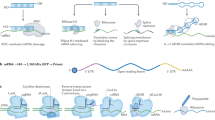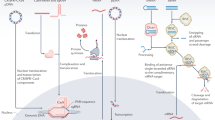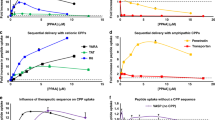Abstract
Low efficiency, significant toxicity, polymer polydispersity and poorly understood delivery mechanisms have initially plagued the field of polymer-based gene therapy. Numerous strategies have helped to improve polyplexes, including the development of biodegradable polymers with reduced toxicity, incorporation of cell targeting, surface shielding and additional transport domains for effective and specific delivery, or improved chemistry for syntheses of polymers with uniform size and topology. Combined biooptical imaging and bioinformatics, providing insights into transfer bottlenecks, have helped to design improved polyplexes. Bioresponsive multifunctional polymers adapt in a dynamic manner to delivery barriers for efficient transfer of pDNA or siRNA to the target site.
This is a preview of subscription content, access via your institution
Access options
Subscribe to this journal
Receive 12 print issues and online access
$259.00 per year
only $21.58 per issue
Buy this article
- Purchase on Springer Link
- Instant access to full article PDF
Prices may be subject to local taxes which are calculated during checkout



Similar content being viewed by others
References
Burke RS, Pun SH . Extracellular barriers to in vivo PEI and PEGylated PEI polyplex-mediated gene delivery to the liver. Bioconjug Chem 2008; 19: 693–704.
Nishiyama N, Arnida, Jang WD, Date K, Miyata K, Kataoka K . Photochemical enhancement of transgene expression by polymeric micelles incorporating plasmid DNA and dendrimer-based photosensitizer. J Drug Target 2006; 14: 413–424.
Meyer M, Philipp A, Oskuee R, Schmidt C, Wagner E . Breathing life into polycations: functionalization with pH-responsive endosomolytic peptides and polyethylene glycol enables siRNA delivery. J Am Chem Soc 2008; 130: 3272–3273.
Huth S, Hoffmann F, von Gersdorff K, Laner A, Reinhardt D, Rosenecker J et al. Interaction of polyamine gene vectors with RNA leads to the dissociation of plasmid DNA-carrier complexes. J Gene Med 2006; 8: 1416–1424.
Chen HH, Ho YP, Jiang X, Mao HQ, Wang TH, Leong KW . Quantitative comparison of intracellular unpacking kinetics of polyplexes by a model constructed from quantum dot-FRET. Mol Ther 2008; 16: 324–332.
Grosse S, Thevenot G, Monsigny M, Fajac I . Which mechanism for nuclear import of plasmid DNA complexed with polyethylenimine derivatives? J Gene Med 2006; 8: 845–851.
Zhou J, Yockman JW, Kim SW, Kern SE . Intracellular kinetics of non-viral gene delivery using polyethylenimine carriers. Pharm Res 2007; 24: 1079–1087.
Breunig M, Lungwitz U, Liebl R, Klar J, Obermayer B, Blunk T et al. Mechanistic insights into linear polyethylenimine-mediated gene transfer. Biochim Biophys Acta 2007; 1770: 196–205.
Dinh AT, Pangarkar C, Theofanous T, Mitragotri S . Understanding intracellular transport processes pertinent to synthetic gene delivery via stochastic simulations and sensitivity analyses. Biophys J 2007; 92: 831–846.
de Bruin K, Ruthardt N, von Gersdorff K, Bausinger R, Wagner E, Ogris M et al. Cellular dynamics of EGF receptor-targeted synthetic viruses. Mol Ther 2007; 15: 1297–1305.
Lai SK, Hida K, Chen C, Hanes J . Characterization of the intracellular dynamics of a non-degradative pathway accessed by polymer nanoparticles. J Control Release 2008; 125: 107–111.
von Gersdorff K, Sanders NN, Vandenbroucke R, De Smedt SC, Wagner E, Ogris M . The internalization route resulting in successful gene expression depends on both cell line and polyethylenimine polyplex type. Mol Ther 2006; 14: 745–753.
Iida T, Mori T, Katayama Y, Niidome T . Overall interaction of cytosolic proteins with the PEI/DNA complex. J Control Release 2007; 118: 364–369.
Han M, Bae Y, Nishiyama N, Miyata K, Oba M, Kataoka K . Transfection study using multicellular tumor spheroids for screening non-viral polymeric gene vectors with low cytotoxicity and high transfection efficiencies. J Control Release 2007; 121: 38–48.
Neu M, Sitterberg J, Bakowsky U, Kissel T . Stabilized nanocarriers for plasmids based upon cross-linked poly(ethylene imine). Biomacromolecules 2006; 7: 3428–3438.
Hong S, Leroueil PR, Janus EK, Peters JL, Kober MM, Islam MT et al. Interaction of polycationic polymers with supported lipid bilayers and cells: nanoscale hole formation and enhanced membrane permeability. Bioconjug Chem 2006; 17: 728–734.
Breunig M, Lungwitz U, Liebl R, Goepferich A . Breaking up the correlation between efficacy and toxicity for nonviral gene delivery. Proc Natl Acad Sci USA 2007; 104: 14454–14459.
Wong SY, Pelet JM, Putnam D . Polymer systems for gene delivery—past, present, future. Prog Polym Sci 2007; 32: 799–837.
Green JJ, Shi J, Chiu E, Leshchiner ES, Langer R, Anderson DG . Biodegradable polymeric vectors for gene delivery to human endothelial cells. Bioconjug Chem 2006; 17: 1162–1169.
Kloeckner J, Bruzzano S, Ogris M, Wagner E . Gene carriers based on hexanediol diacrylate linked oligoethylenimine: effect of chemical structure of polymer on biological properties. Bioconjug Chem 2006; 17: 1339–1345.
Thomas M, Lu JJ, Zhang C, Chen J, Klibanov AM . Identification of novel superior polycationic vectors for gene delivery by high-throughput synthesis and screening of a combinatorial library. Pharm Res 2007; 24: 1564–1571.
Russ V, Elfberg H, Thoma C, Kloeckner J, Ogris M, Wagner E . Novel degradable oligoethylenimine acrylate ester-based pseudodendrimers for in vitro and in vivo gene transfer. Gene Ther 2008; 15: 18–29.
Lee Y, Mo H, Koo H, Park JY, Cho MY, Jin GW et al. Visualization of the degradation of a disulfide polymer, linear poly(ethylenimine sulfide), for gene delivery. Bioconjug Chem 2007; 18: 13–18.
Manickam DS, Oupicky D . Multiblock reducible copolypeptides containing histidine-rich and nuclear localization sequences for gene delivery. Bioconjug Chem 2006; 17: 1395–1403.
Hoon JJ, Christensen LV, Yockman JW, Zhong Z, Engbersen JF, Jong KW et al. Reducible poly(amido ethylenimine) directed to enhance RNA interference. Biomaterials 2007; 28: 1912–1917.
Lin C, Blaauboer CJ, Timoneda MM, Lok MC, van Steenbergen M, Hennink WE et al. Bioreducible poly(amido amine)s with oligoamine side chains: synthesis, characterization, and structural effects on gene delivery. J Control Release 2008; 126: 166–174.
Wang XL, Ramusovic S, Nguyen T, Lu ZR . Novel polymerizable surfactants with pH-sensitive amphiphilicity and cell membrane disruption for efficient siRNA delivery. Bioconjug Chem 2007; 18: 2169–2177.
Lee CC, Liu Y, Reineke TM . General structure-activity relationship for poly(glycoamidoamine)s: the effect of amine density on cytotoxicity and DNA delivery efficiency. Bioconjug Chem 2008; 19: 428–440.
Hartmann L, Krause E, Antonietti M, Borner HG . Solid-phase supported polymer synthesis of sequence-defined, multifunctional poly(amidoamines). Biomacromolecules 2006; 7: 1239–1244.
Hartmann L, Hafele S, Peschka-Suss R, Antonietti M, Borner HG . Tailor-Made Poly(amidoamine)s for Controlled Complexation and Condensation of DNA. Chemistry 2008; 14: 2025–2033.
DeRouchey J, Schmidt C, Walker GF, Koch C, Plank C, Wagner E et al. Monomolecular assembly of siRNA and poly(ethylene glycol)-peptide copolymers. Biomacromolecules 2008; 9: 724–732.
de Fougerolles AR . Delivery vehicles for small interfering RNA in vivo. Hum Gene Ther 2008; 19: 125–132.
Aigner A . Gene silencing through RNA interference (RNAi) in vivo: strategies based on the direct application of siRNAs. J Biotechnol 2006; 124: 12–25.
Meyer M, Wagner E . Recent developments in the application of plasmid DNA-based vectors and small interfering RNA therapeutics for cancer. Hum Gene Ther 2006; 17: 1062–1076.
Aagaard L, Rossi JJ . RNAi therapeutics: principles, prospects and challenges. Adv Drug Deliv Rev 2007; 59: 75–86.
Rozema DB, Lewis DL, Wakefield DH, Wong SC, Klein JJ, Roesch PL et al. Dynamic Polyconjugates for targeted in vivo delivery of siRNA to hepatocytes. Proc Natl Acad Sci USA 2007; 104: 12982–12987.
Bolcato-Bellemin AL, Bonnet ME, Creusat G, Erbacher P, Behr JP . Sticky overhangs enhance siRNA-mediated gene silencing. Proc Natl Acad Sci USA 2007; 104: 16050–16055.
Tarcha PJ, Pelisek J, Merdan T, Waters J, Cheung K, von Gersdorff K et al. Synthesis and characterization of chemically condensed oligoethylenimine containing beta-aminopropionamide linkages for siRNA delivery. Biomaterials 2007; 28: 3731–3740.
Mao S, Neu M, Germershaus O, Merkel O, Sitterberg J, Bakowsky U et al. Influence of polyethylene glycol chain length on the physicochemical and biological properties of poly(ethylene imine)-graft-poly(ethylene glycol) block copolymer/SiRNA polyplexes. Bioconjug Chem 2006; 17: 1209–1218.
Malek A, Czubayko F, Aigner A . PEG grafting of polyethylenimine (PEI) exerts different effects on DNA transfection and siRNA-induced gene targeting efficacy. J Drug Target 2008; 16: 124–139.
Katas H, Alpar HO . Development and characterisation of chitosan nanoparticles for siRNA delivery. J Control Release 2006; 115: 216–225.
Howard KA, Rahbek UL, Liu X, Damgaard CK, Glud SZ, Andersen MO et al. RNA interference in vitro and in vivo using a novel chitosan/siRNA nanoparticle system. Mol Ther 2006; 14: 476–484.
Pille JY, Li H, Blot E, Bertrand JR, Pritchard LL, Opolon P et al. Intravenous delivery of anti-RhoA small interfering RNA loaded in nanoparticles of chitosan in mice: safety and efficacy in xenografted aggressive breast cancer. Hum Gene Ther 2006; 17: 1019–1026.
Bartlett DW, Davis ME . Impact of tumor-specific targeting and dosing schedule on tumor growth inhibition after intravenous administration of siRNA-containing nanoparticles. Biotechnol Bioeng 2008; 99: 975–985.
Bartlett DW, Su H, Hildebrandt IJ, Weber WA, Davis ME . Impact of tumor-specific targeting on the biodistribution and efficacy of siRNA nanoparticles measured by multimodality in vivo imaging. Proc Natl Acad Sci USA 2007; 104: 15549–15554.
Kumar P, Wu H, McBride JL, Jung KE, Kim MH, Davidson BL et al. Transvascular delivery of small interfering RNA to the central nervous system. Nature 2007; 448: 39–43.
Moffatt S, Wiehle S, Cristiano RJ . A multifunctional PEI-based cationic polyplex for enhanced systemic p53-mediated gene therapy. Gene Ther 2006; 13: 1512–1523.
Rao GA, Tsai R, Roura D, Hughes JA . Evaluation of the transfection property of a peptide ligand for the fibroblast growth factor receptor as part of PEGylated polyethylenimine polyplex. J Drug Target 2008; 16: 79–89.
Wood KC, Azarin SM, Arap W, Pasqualini R, Langer R, Hammond PT . Tumor-targeted gene delivery using molecularly engineered hybrid polymers functionalized with a tumor-homing peptide. Bioconjug Chem 2008; 19: 403–405.
Shir A, Ogris M, Wagner E, Levitzki A . EGF receptor-targeted synthetic double-stranded RNA eliminates glioblastoma, breast cancer, and adenocarcinoma tumors in mice. PLoS Med 2006; 3: e6.
Wagner E . Converging paths of viral and non-viral vector engineering. Mol Ther 2008; 16: 1–2.
Howard KA, Dong M, Oupicky D, Bisht HS, Buss C, Besenbacher F et al. Nanocarrier stimuli-activated gene delivery. Small 2007; 3: 54–57.
Wagner E . Programmed drug delivery: nanosystems for tumor targeting. Expert Opin Biol Ther 2007; 7: 587–593.
Wolff JA, Rozema DB . Breaking the bonds: non-viral vectors become chemically dynamic. Mol Ther 2008; 16: 8–15.
Dobson J . Gene therapy progress and prospects: magnetic nanoparticle-based gene delivery. Gene Ther 2006; 13: 283–287.
Ndoye A, Dolivet G, Hogset A, Leroux A, Fifre A, Erbacher P et al. Eradication of p53-mutated head and neck squamous cell carcinoma xenografts using nonviral p53 gene therapy and photochemical internalization. Mol Ther 2006; 13: 1156–1162.
Knorr V, Allmendinger L, Walker GF, Paintner FF, Wagner E . An acetal-based PEGylation reagent for pH-sensitive shielding of DNA polyplexes. Bioconjug Chem 2007; 18: 1218–1225.
Judge A, MacLachlan I . Overcoming the innate immune response to small interfering RNA. Hum Gene Ther 2008; 19: 111–124.
Author information
Authors and Affiliations
Corresponding author
Rights and permissions
About this article
Cite this article
Schaffert, D., Wagner, E. Gene therapy progress and prospects: synthetic polymer-based systems. Gene Ther 15, 1131–1138 (2008). https://doi.org/10.1038/gt.2008.105
Received:
Revised:
Accepted:
Published:
Issue Date:
DOI: https://doi.org/10.1038/gt.2008.105
Keywords
This article is cited by
-
Classifications, synthesis and applications of biodegradable pseudo-proteins: a review
Macromolecular Research (2024)
-
Pyrrolidine-based cationic γ-peptide: a DNA-binding molecule works as a potent anti-gene agent
Medicinal Chemistry Research (2022)
-
Delivery of transcription factors as modulators of cell differentiation
Drug Delivery and Translational Research (2021)
-
Redox-responsive micelles self-assembled from multi-block copolymer for co-delivery of siRNA and hydrophobic anticancer drug
Polymer Bulletin (2019)
-
Supramolecular dendritic polymers for diagnostic and theranostic applications
Science China Materials (2018)



